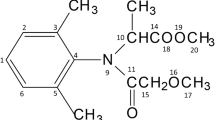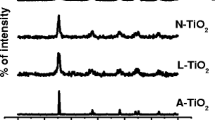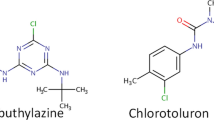Abstract
The objective of this work is double—firstly to explore the photocatalytic efficiency of five different commercial TiO2 catalysts in the photodegradation of a mixture of pesticides classified by the EU as priority pollutants and secondly to analyze the correlation between their physicochemical properties and the inhibition of the studied photocatalytic process when natural water was employed. Photocatalytic efficiencies when ultrapure water was used seem to point out that surface area was not a prerequisite for the photodegradation of the selected mixture of pesticides. On the other hand, significant differences in total organic carbon (TOC) conversions were obtained with the two studied water compositions. On one side, Evonik materials appear to be mostly inhibited when natural water was employed, whereas on the other, it should be remarked that anatase Sigma-Aldrich (SA) and, particularly, Hombikat UV100 (HBK) materials presented a very limited photo-efficiency inhibition or even a higher initial rate of TOC removal when a natural water matrix was used, probably due to their specific surface properties (PZC, S BET). Therefore, heterogeneous photocatalysis has proved to be a promising technology for the degradation of the selected mixture of pesticides where the final photo-efficiency of the five commercial titania catalysts studied here responds to a complex balance between its surface and structural properties.




Similar content being viewed by others
References
Ahmed S, Rasul MG, Brown R, Hashib MA (2011) Influence of parameters on the heterogeneous photocatalytic degradation of pesticides and phenolic contaminants in wastewater: a short review. J Environ Manage 92:311–330
Ahmed S, Rasul MG, Martens WN, Brown R, Hashib MA (2010) Heterogeneous photocatalytic degradation of phenols in wastewater: a review on current status and developments. Desalination 261:3–18
Bickley RI, Gonzalez Carreño T, Lees JS, Palmisano L, Tilley RJD (1991) A structural investigation of titanium dioxide photocatalysts. J Solid State Chem 92:178–190
Carbonaro S, Sugihara MN, Strathmann TJ (2013) Continuous-flow photocatalytic treatment of pharmaceutical micropollutants: activity, inhibition, and deactivation of TiO2 photocatalysts in wastewater effluent. Appl Catal B Environ 129:1–12
Chong MN, Jin B, Chow CWK, Saint C (2010) Recent developments in photocatalytic water treatment technology: a review. Water Res 44:2997–3027
Enriquez R, Agrios AG, Pichat P (2007) Probing multiple effects of TiO2 sintering temperature on photocatalytic activity in water by use of a series of organic pollutant molecules. Catal Today 120:196–202
EU Directive 2008/105/EC of European Parliament and of the Council on environmental quality standards in the field of water policy, amending and subsequently repealing Council Directives 82/176/EEC, 83/513/EEC, 84/156/EEC, 84/491/EEC, 86/280/EEC and amending Directive 2000/60/EC
Friedmann D, Mendive C, Bahnemann DW (2010) TiO2 for water treatment: parameters affecting the kinetics and mechanisms of photocatalysis. Appl Catal B Environ 99:398–406
Hincapie-Perez M, Peñuela G, Maldonado MI, Malato O, Fernandez-Ibañez P, Oller I, Gernjak W, Malato S (2006) Degradation of pesticides in water using solar advanced oxidation processes. Appl Catal B Environ 64:272–281
Hoffmann MR, Martin ST, Choi W, Bahnemann DW (1995) Environmental applications of semiconductor photocatalysis. Chem Rev 95:69–96
Klamerth N, Miranda N, Malato S, Agüera A, Fernández-Alba AR, Maldonado MI, Coronado JM (2009) Degradation of emerging contaminants at low concentrations in MWTPs effluents with mild solar photo-Fenton and TiO2. Catal Today 144:124–130
Lapertot M, Pulgarín C, Fernández-Ibáñez P, Maldonado MI, Pérez-Estrada L, Oller I, Gernjak W, Malato S (2006) Enhancing biodegradability of priority substances (pesticides) by solar photo-Fenton. Water Res 40:1086–1094
Malato S, Fernández-Ibáñez P, Maldonado MI, Blanco J, Gernjak W (2009) Decontamination and disinfection of water by solar photocatalysis: recent overview and trends. Catal Today 147:1–59
Maldonado MI, Passarinho PC, Oller I, Gernjak W, Fernández P, Blanco J, Malato S (2007) Photocatalytic degradation of EU priority substances: a comparison between TiO2 and Fenton plus photo-Fenton in a solar pilot plant. J Photoch Photobio A 185:354–363
Nagaveni K, Sivalingam G, Hegde MS, Madras G (2004) Solar photocatalytic degradation of dyes: high activity of combustion synthesized nano TiO2. Appl Catal B Environ 48:83–93
Ohno T, Tokieda K, Higashida S, Matsumura M (2003) Synergism between rutile and anatase TiO2 particles inphotocatalytic oxidation of naphthalene. Appl Catal A Gen 244:383–391
Prieto-Mahaney OO, Murakami N, Abe R, Ohtani B (2009) Correlation between photocatalytic activities and structural and physical properties of titanium(IV) oxide powders. Chem Lett 38:238–239
Ryu J, Choi W (2008) Substrate-specific photocatalytic activities of TiO2 and multiactivity test for water treatment application. Environ Sci Technol 42:294–300
Sanchis S, Polo AM, Tobajas M, Rodríguez JJ, Mohedano AF (2013) Strategies to evaluate biodegradability: application to chlorinated herbicides. Environ Sci Pollut Res. doi:10.1007/s11356-013-2130-y
Scotti R, D'Arenzo TA, Morazzoni F (2009) Photocatalytic mineralization of phenol catalyzed by pure and mixed phase hydrothermal titanium dioxide. Appl Catal B Environ 88:497–504
Serpone N, Lawless D, Khairutdinovt R (1995) Size effects on the photophysical properties of colloidal anatase TiO2 particles: size quantization or direct transitions in this indirect semiconductor? J Phys Chem 99:16646–16654
Sirtori C, Agüera A, Gernjak W, Malato S (2010) Effect of water-matrix composition on Trimethoprim solar photodegradation kinetics and pathways. Water Res 44:2735–2744
Standard Methods (2012) Standard methods for the examination of water and wastewater, 22nd Edition, 2012. APHA, AWWA, WPCF, ISBN 978-087553-013-0, ISSN 55-1979
Zalazar CS, Romero RL, Martín CA, Cassano AE (2005) Photocatalytic intrinsic reaction kinetics I: mineralization of dichloroacetic acid. Chem Eng Sci 60:5240–5254
Zhang W, Li Y, Su Y, Mao K, Wang Q (2012) Effect of water composition on TiO2 photocatalytic removal of endocrine disrupting compounds (EDCs) and estrogenic activity from secondary effluent. J Hazard Mat 215–216:252–258
Acknowledgments
This work has been supported by the Spanish Plan Nacional de I + D + i through the project CTM2010-14883/TECNO.
Author information
Authors and Affiliations
Corresponding author
Additional information
Responsible editor: Philippe Garrigues
Rights and permissions
About this article
Cite this article
Carbajo, J., García-Muñoz, P., Tolosana-Moranchel, A. et al. Effect of water composition on the photocatalytic removal of pesticides with different TiO2 catalysts. Environ Sci Pollut Res 21, 12233–12240 (2014). https://doi.org/10.1007/s11356-014-3111-5
Received:
Accepted:
Published:
Issue Date:
DOI: https://doi.org/10.1007/s11356-014-3111-5




